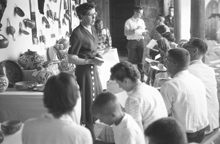Katharine Bartlett facts for kids
Katharine Bartlett (1907–2001) was an important American scientist. She was a physical anthropologist, which means she studied humans, their development, and their cultures.
She worked at the Museum of Northern Arizona (MNA) for many years. First, she was the museum's first curator from 1930 to 1952. A curator is someone who organizes and takes care of a museum's collections. Later, she became the museum's librarian until 1981.
Katharine also explored parts of the Navajo Nation and helped set up a system for organizing artifacts from the Glen Canyon Archaeological Project. She received many honors for her work, including being recognized by the Smithsonian Institution and inducted into the Arizona Women's Hall of Fame.
Contents
Early Life and Education
Katharine Bartlett was born on November 30, 1907, in Denver, Colorado. Her parents were Louise Erina and George Frederick Bartlett.
She wanted to go to Smith College, but it was too expensive. Instead, she earned her master's degree in physical anthropology from the University of Denver. She studied under a professor named Etienne Bernardeau Renaud.
Starting Her Museum Career
In 1930, Katharine got a summer job at the Museum of Northern Arizona (MNA). She helped with an exhibit about Hopi crafts. The museum was only two years old at the time.
Harold Sellers Colton, a leading expert on the Southwest, invited Katharine to stay. He and his wife had founded the MNA. Katharine's job was to organize the museum's collections.
Organizing the Museum
From 1930 to 1952, Katharine worked as the museum's curator. She organized, cataloged, and took care of the museum's anthropology collection. This means she made sure everything was properly identified and preserved.
Exploring Ancient Sites
In 1931, Katharine and Harold Colton explored the Navajo Reservation. They covered 250 miles of the reservation in the Little Colorado River basin. They found and mapped 260 ancient sites.
Her work on artifacts from the Tolchaco area was some of the first research on Paleo-Indians in that region. Paleo-Indians were some of the earliest people to live in North America.
Recognized for Her Work
In 1935, Katharine was one of the first four women chosen as Fellows of the Society for American Archaeology. This was a big honor for her contributions to the study of ancient cultures.
In 1946, she presented research that corrected earlier ideas about ancient cultures. Her work showed that there was no break between the Folsom tradition and later cultures.
Glen Canyon Project
In 1952, Katharine's housemate, Gene Field Foster, started recording ancient sites where the Glen Canyon Dam was being built. Katharine and the MNA were invited to help.
Katharine created the system for organizing the artifacts from the Glen Canyon Project. This was a very large project to save archaeological findings. The surveying in Glen Canyon continued for more than five years.
Writing and Research
Starting in 1928, Katharine published many articles about the Native people and cultures of Arizona. Her scientific papers covered topics like:
- Ancient mines
- Artifacts (old tools and objects)
- Foods
- History
- Prehistoric tools
- Crafts of the Hopi, Navajo, and other Arizona tribes
Her article Pueblo Milling Stones of the Flagstaff Region and Their Relation to Others in the Southwest: A Study in Progressive Efficiency became a very important reference. It helped people understand how ancient tools were used to process food.
Becoming a Librarian
From 1953 until she retired in 1981, Katharine worked as the Librarian of the MNA. She collected thousands of books and resources. This helped create a complete research library in northern Arizona.
Awards and Later Life
Katharine was a founding member of the Arizona Academy of Science and the Arizona Association of University Women. She was also a Fellow of several important scientific groups, including the American Association for the Advancement of Science. She was the first Fellow of the MNA.
In 1986, the Smithsonian Institution honored her with an exhibit called “Daughter of the Desert.” In 1991, she received the Sharlot Hall Award for her contributions to Arizona history.
Katharine retired in 1981 to care for her housemate, Gene Foster, who passed away in 1983. In the 1990s, Katharine continued to volunteer at the MNA.
Katharine Bartlett passed away on May 22, 2001, in Sedona, Arizona. In 2008, she was honored by being added to the Arizona Women's Hall of Fame.


